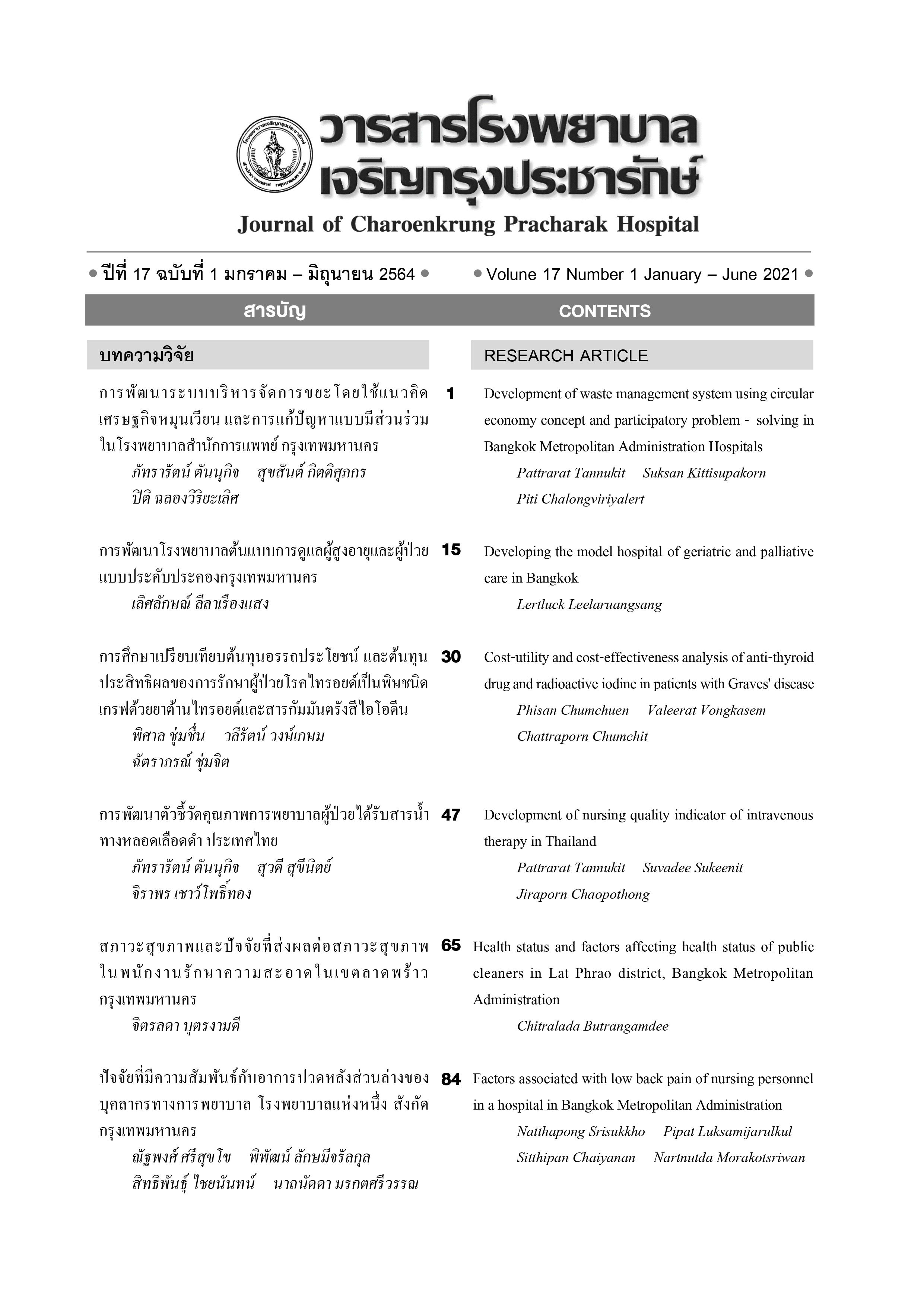การศึกษาเปรียบเทียบต้นทุนอรรถประโยชน์ และต้นทุนประสิทธิผลของการรักษาผู้ป่วยโรคไทรอยด์เป็นพิษ ชนิดเกรฟด้วยยาต้านไทรอยด์และสารกัมมันตรังสีไอโอดีน
Main Article Content
บทคัดย่อ
วัตถุประสงค์:การวิจัยนี้ต้องการเปรียบเทียบต้นทุนผลของการรักษาด้านคุณภาพชีวิตและประสิทธิผลของการรักษาในรูปแบบต้นทุนอรรถประโยชน์ และต้นทุนประสิทธิผลระหว่างยาต้านไทรอยด์กับสารกัมมันตรังสีไอโอดีนในผู้ป่วยโรคไทรอยด์เป็นพิษชนิดเกรฟโรงพยาบาลดำเนินสะดวกจังหวัดราชบุรี
วิธีดำเนินการวิจัย: เป็นการวิจัยวิเคราะห์ต้นทุนอรรถประโยชน์ และต้นทุนประสิทธิผลของการรักษา เป็นระยะเวลา 6 ปี ในช่วงเวลาตั้งแต่ กรกฎาคม พ.ศ. 2557 ถึง กรกฎาคม พ.ศ. 2563 ในผู้ป่วย 182 รายโดยเป็นผู้ป่วยที่รักษาด้วยยาต้านไทรอยด์ 151 ราย และสารกัมมันตรังสีไอโอดีน 31 ราย เก็บข้อมูลต้นทุนการรักษา และอรรถประโยชน์ด้วยแบบประเมินคุณภาพชีวิตจากแบบสอบถามEuroQol - 5 Dimension (EQ-5D) เปรียบเทียบแต่ละชนิดการรักษาด้วย independent t-test
ผลการวิจัย:เมื่อรักษาครบ 2 ปี พบว่าต้นทุนผู้ป่วยที่รักษาด้วยสารกัมมันตรังสีไอโอดีนสูงกว่ายาต้านไทรอยด์ (p<0.01) ผู้ป่วยที่รักษาด้วยสารกัมมันตรังสีไอโอดีนมีการเพิ่มของคะแนนอรรถประโยชน์มากกว่าผู้ป่วยที่รักษาด้วยยาต้านไทรอยด์ (p=0.034) และพบว่าผู้ป่วยที่รักษาด้วยสารกัมมันตรังสีไอโอดีนมีอัตราหายป่วยสูงกว่าผู้ป่วยที่รักษาด้วยยาต้านไทรอยด์ (p<0.01) ต้นทุนอรรถประโยชน์ของผู้ป่วยโรคไทรอยด์เป็นพิษชนิดเกรฟที่ได้รับการรักษาด้วยยาต้านไทรอยด์และของผู้ป่วยโรคไทรอยด์เป็นพิษชนิดเกรฟที่ได้รับการรักษาด้วยสารกัมมันตรังสีไอโอดีนเท่ากับ 12,305.83 และ 20,186.76 บาท ตามลำดับ ผู้ป่วยที่ได้รับการรักษาด้วยสารกัมมันตรังสีไอโอดีนมีต้นทุนประสิทธิผลสูงกว่าผู้ป่วยที่ได้รับการรักษาด้วยยาต้านไทรอยด์ (578.93 กับ 120.07 บาทตามลำดับ)
สรุป: ในด้านเศรษฐศาสตร์พบว่าการรักษาผู้ป่วยโรคไทรอยด์เป็นพิษชนิดเกรฟด้วยสารกัมมันตรังสีไอโอดีนมีต้นทุนอรรถประโยชน์ และต้นทุนประสิทธิผลสูงกว่าการรักษาด้วยยาต้านไทรอยด์ แต่เมื่อพิจารณาด้านผลลัพธ์ทางคลินิก และคุณภาพชีวิต พบว่าผู้ป่วยโรคไทรอยด์เป็นพิษชนิดเกรฟที่รักษาด้วยสารกัมมันตรังสีไอโอดีนมีอัตราการหายสูงกว่า การเปลี่ยนแปลงคุณภาพชีวิต (อรรถประโยชน์) ดีกว่าผู้วิจัยมีความเห็นว่าการเลือกการรักษาด้วยสารกัมมันตรังสีไอโอดีนเหมาะสมกับผู้ป่วยที่มีอาการของโรครุนแรง
คำสำคัญ: ต้นทุนอรรถประโยชน์ต้นทุนประสิทธิผลโรคไทรอยด์เป็นพิษชนิดเกรฟ
Article Details
เอกสารอ้างอิง
Bartalena L. Diagnosis and management of Graves disease: a global overview. Nat Rev Endocrinol
[Internet]. 2013 [cited 2019 Sep 15];9:724 - 34. Available from: http://www.ncbi.nlm.nih.gov/
pubmed/24126481.
พรรณทิพา ศักดิ์ทอง. คุณภาพชีวิตด้านสุขภาพ. กรุงเทพฯ: สำนักพิมพ์จุฬาลงกรณ์มหาวิทยาลัย; 2554.
วลีรัตน์ วงษ์เกษม, สุรสิทธิ์ ล้อจิตรอํานวย. อรรถประโยชน์ด้านสุขภาพของวิธีการรักษาโรคคอพอก
เป็นพิษจาก Graves' diease ในโรงพยาบาลดำเนินสะดวก. วารสารการแพทย์และวิทยาศาสตร์สุขภาพ
;19:38-45.
อุษา ฉายเกล็ดแก้ว, บรรณาธิการ. คู่มือการประเมินเทคโนโลยีด้านสุขภาพสําหรับประเทศ.
กรุงเทพฯ: บริษัท เดอะ กราฟิโก ซิสเต็มส์ จํากัด; 2552.
Tongsiri S. Valuing preferences for EQ-5D health states in the Thai general population. 2009.
Sakthong P, Charoenvisuthiwongs R, Shabunthom R. A comparison of EQ-5D index scores using the
UK, US, and Japan preference weights in a Thai sample with type 2 diabetes. Health Qual Life
Outcomes [Internet]. 2008 [cited 2020 Jan 26];6: 1-9 . Available from: https://pubmed.ncbi.nlm.nih.
gov/18811935/.
In H, Pearce EN, Wong AK, Burgess JF, McAneny DB, Rosen JE. Treatment options for Graves
disease: A cost-effectiveness analysis. J Am Coll Surg 2009; 209: 170-9.
Terwee CB, Gerding MN, Dekker FW, Prummel MF, Wiersinga WM. Development of a disease
specific quality of life questionnaire for patients with Graves’ ophthalmopathy: The GO-QOL. Br J
Ophthalmol [Internet]. 1998 [cited 2020 Oct 17];82:773-9. Available from: http://bjo.bmj.com/.
Park JJ, Sullivan TJ, Mortimer RH, Wagenaar M, Perry-Keene DA. Assessing quality of life in
Australian patients with Graves’ ophthalmopathy. Br J Ophthalmol [Internet]. 2004 [cited 2020 Oct
;88:75-8. Available from: http://bjo.bmj.com/.
Lumyongsatien M, Keeratidamkerngsakul B, Pornpanich K, Vangveeravong S, Saonanon P,
Wiwatwongwana D, et al. Development and psychometric properties of the Thai Graves’
ophthalmopathy quality of life (GO-QOL) questionnaire. J Patient-Reported Outcomes [Internet].
[cited 2020 Oct 17]; 4:1. Available from: https://jpro.springeropen.com/articles/ 10.1186/
s41687-019-0164-8.
Törring O, Watt T, Sjölin G, Byström K, Abraham-Nordling M, Calissendorff J, et al. Impaired
quality of life after radioiodine therapy compared to antithyroid drugs or surgical treatment for
Graves’ hyperthyroidism: A long-term follow-up with the thyroid-related patient-reported outcome
questionnaire and 36-item short form health status survey. Thyroid 2019;29:322-31.
Lee SY. Quality of life is worse at 6-10 years after radioactive iodine treatment of Graves’ disease as
compared with antithyroid drugs or surgery. Clin Thyroidol [Internet]. 2019 [cited 2020 Oct 17];
:144-7. Available from: www.liebertpub.com.
Conaglen HM, Tamatea JAU, Conaglen J V., Elston MS. Treatment choice, satisfaction and quality
of life in patients with Graves’ disease. Clin Endocrinol (Oxf) [Internet]. 2018 [cited 2020 Oct 17];
:977-84. Available from: http://doi.wiley.com/10.1111/cen.13611.
Hayashi K, Abe K, Sakata I, Sakaguchi C, Yamamoto K, Kosuda S. [Cost-utility analysis of
antithyroid drug therapy versus 131I therapy for Graves’ disease]. Kaku Igaku [Internet]. 2005 [cited
Feb 1];42:87-95. Available from: http://www.ncbi.nlm.nih.gov/pubmed/16038427.
Donovan PJ, McLeod DSA, Little R, Gordon L. Cost-utility analysis comparing radioactive iodine,
anti-thyroid drugs and total thyroidectomy for primary treatment of Graves’ disease. Eur J Endocrinol
[Internet]. 2016 [cited 2020 Oct 17];175:595-603. Available from: https://pubmed.ncbi.nlm.nih.gov/
/.
Cruz AF Junior, Takahashi MH, Albino CC. Graves’ disease: cost-effectiveness of clinical and
radioiodine treatments. Thyroid[Internet]. 2005 [cited 2020 Oct 17]; 15suppl1: S-201. Available
from: http://www.13itc.org/information.html.
Starling S. Long-term treatment outcomes for Graves disease. Nature Reviews Endocrinology
[Internet]. 2019[cited 2020 Oct 17]; 5: 628. Available from: https://www.nature.com/articles/s41574-
-0268-5.


